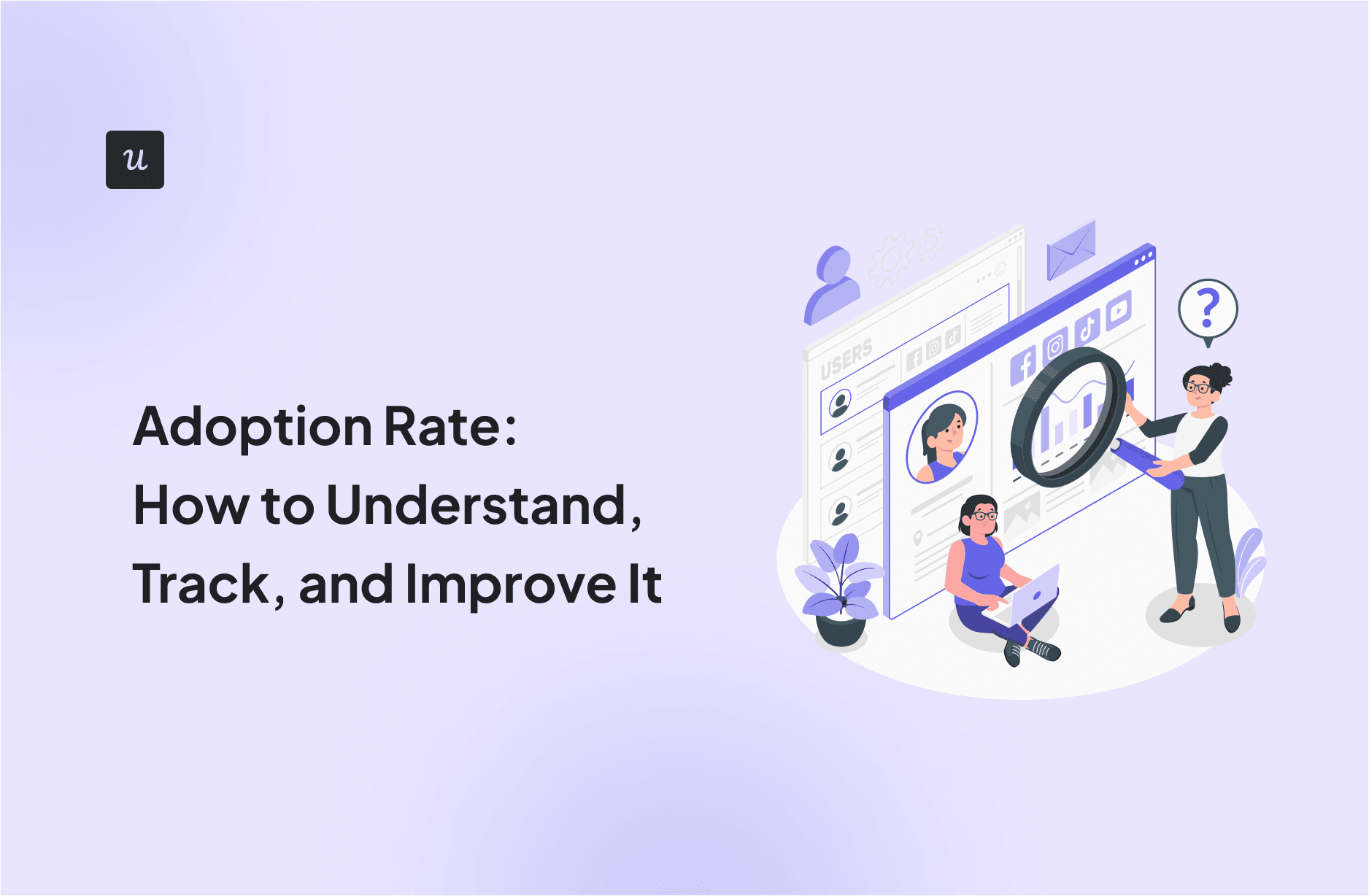
What’s one of the biggest factors impacting how many users use your product? Your adoption rate. The higher your adoption rate, the more customers will use your product, resulting in more revenue.
This article will look at what the adoption rate is, what factors influence it, how you can calculate your adoption rate, and how to improve it.
Try Userpilot Now
See Why 1,000+ Teams Choose Userpilot

Adoption rate summary
- Adoption rate measures how quickly new features or products gain popularity and usage, indicating their success and user appeal.
- The product adoption process includes six stages: Awareness, Interest, Evaluation, Trial, Activation, and Adoption, each crucial to a product’s market integration.
- Quick product adoption hinges on user experience, effective promotion, strategic pricing, and strong customer support, each shaping user acceptance and satisfaction.
- To boost product adoption metrics, define clear goals, identify and understand the target audience’s needs, aligning the product’s features to these to ensure relevance and value.
- Enhancing the user onboarding process with welcome pages, interactive tours, progress indicators, and targeted emails can significantly speed up user engagement and product adoption.
- Intuitive, user-friendly design is crucial for product adoption; it minimizes user frustration, enhances usability, and encourages feature exploration.
- Enhance product adoption metrics with in-app tutorials, interactive walkthroughs, tooltips, and feature highlights that educate users seamlessly within the app context.
- Boosting product adoption metrics requires accessible support: combine in-app resources, AI chatbots, live chat, forums, and email support to ensure immediate and effective user assistance.
- Adoption is boosted by a clear, fair pricing model aligned with user needs and product value, fostering trust and ease of understanding.
- Continuously enhance your product by analyzing user feedback and performance data to maintain relevance, improve new features, and boost adoption rates.
- To measure product adoption rate, calculate the percentage of new active users out of total signups and monitor key metrics like DAU/MAU, churn rate, and CLV for strategy refinement.
- Userpilot helps enhance product adoption through customizable onboarding flows, tailored in-app experiences, detailed usage analytics, and A/B testing to optimize user engagement and satisfaction. Book a demo now to find out more.
What is adoption rate?
The adoption rate measures how quickly a new feature or product is embraced and used by people after it is introduced. It tells you how fast a product moves from its launch to being widely accepted and utilized.
Understanding the adoption rate is vital as it helps gauge your products’ success and features. It provides insights into user preferences and behaviors, guiding you to enhance your offerings and better serve your customers.
Stages of the product adoption process
A new product doesn’t become a hit overnight when it hits the market. It goes through several stages before it is widely accepted. Here are the six stages of the product adoption process:
- Awareness: This is the initial stage where you first hear about the product. It could be through an advertisement, a friend, or social media. At this point, you’re simply aware that the product exists.
- Interest: Now that you know about the product, you show interest. You might search for more information online or ask others what they think. This stage is all about getting curious and wanting to know more.
- Evaluation: After sparking interest, you evaluate whether this product is right for you. You compare it with similar items, check reviews, and weigh the pros and cons. This is a critical thinking stage where you decide if it meets your needs.
- Trial: If the product passes your evaluation, you might try it out. This could be a free software trial that lets you experience the product without fully committing to it.
- Activation: Activation is when you start using the product. It’s moved from something you’re testing out to a part of your routine. This stage is crucial for the product to make a lasting impact.
- Adoption: The adoption stage is when the product becomes a regular part of your life. You’ve fully accepted it and possibly even recommended it to others. At this point, the product has successfully integrated into your daily activities.
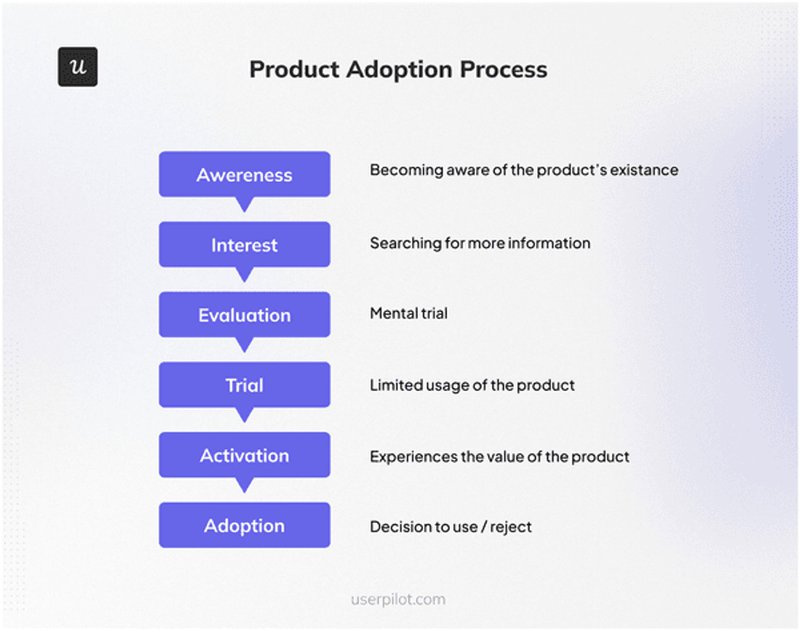
Factors influencing the adoption rate
Several key factors can heavily affect how quickly a product or feature is adopted. Understanding these can help businesses tailor their strategies to enhance the adoption process. Here are some of the main factors:
- User experience: If a product is easy to use, looks good, and performs well, people are likelier to adopt it quickly.
- Promotion and marketing: Effective marketing efforts can create awareness and interest, driving more people to try and eventually adopt the product.
- Pricing model: Affordable or flexible pricing (such as subscriptions or tiered pricing) can make the product accessible to a broader audience.
- Customer support: Good customer support can enhance the adoption process by resolving users’ issues and providing helpful information when needed.
7 key strategies to increase adoption rate
Boosting the adoption rate of a product or feature requires a deliberate approach. Here are seven effective strategies businesses can use to encourage more users to embrace and regularly use their offerings.
1. Define objectives
Before you can increase your product’s adoption rate, defining what you aim to achieve is essential. Know who your users are and understand what they want to accomplish with your product or feature.
This means identifying your target audience and recognizing their needs and goals. By aligning your product’s capabilities with user objectives, you make it more relevant and valuable to them, encouraging quicker and broader adoption.
2. Refine the onboarding process
Onboarding is often a user’s first real interaction with your product, and making a strong first impression can lead to a quicker understanding and appreciation of your product’s value. This, in turn, reduces the time to value—how quickly users can find value in the product—which boosts customer satisfaction.
Effective product onboarding includes several elements designed to guide new users:
- Welcoming pages that greet users warmly.
- Interactive product tours that show key features and how to use them.
- Progress indicators like bars or checklists that help users see their setup journey.
- Targeted email onboarding sequences to provide additional support and information.
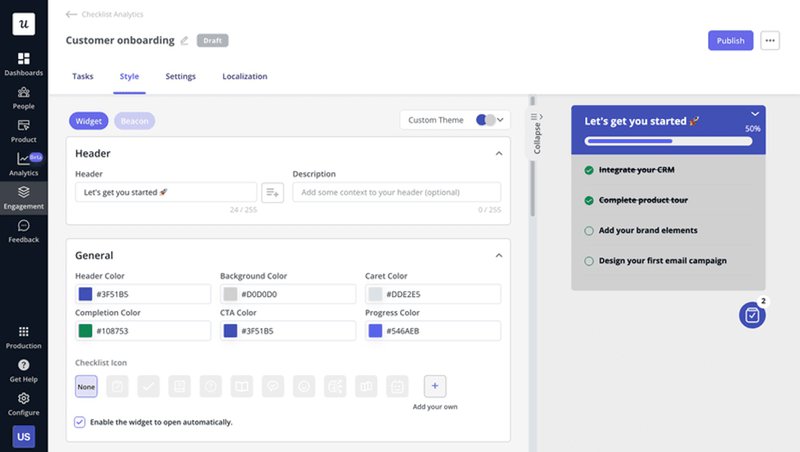
3. Build an intuitive product design
Your product’s design plays a pivotal role in its adoption. A user-friendly, simple, and intuitive design ensures new users can navigate and use your product without confusion or frustration.
Focusing on removing complexities and enhancing usability enables users to have a more enjoyable and effective experience. This helps retain users and encourages them to explore more features, ultimately leading to higher adoption rates.
4. Provide contextual in-app experiences
To boost adoption rates, it’s crucial to alert users to get the most out of your product right where they are: inside the app. In-app tutorials offer a seamless way to provide this guidance without disrupting the user’s workflow. These tools use a contextual and proactive approach to learning, delivering help exactly when and where needed.
Employ interactive walkthroughs and tutorials that guide users step-by-step through your app’s functionality. Utilize tooltips to explain lesser-known features or complex functionalities succinctly. Moreover, feature announcements and highlights can draw attention to new or underused features, ensuring that users know all the tools.
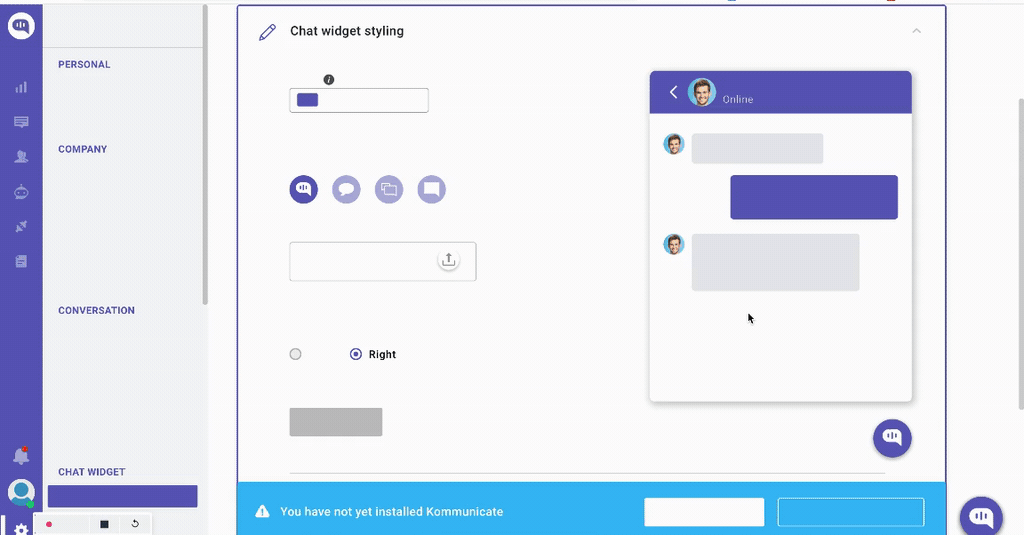
5. Make help accessible
Ensuring that help is always within reach can significantly influence adoption rates of your product. Offer a blend of in-app resources and traditional support options to cover all bases. In-app resources like resource centers, product tours, and video tutorials empower users to learn at their own pace and on their own terms.
For more direct assistance, include AI chatbots for quick and automated help, live chat, support forums, and email support for in-depth inquiries.
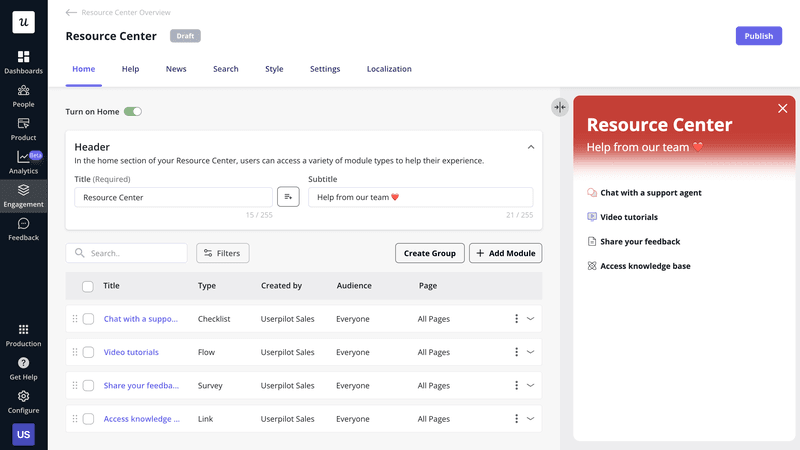
6. Have a clear pricing model
A straightforward and transparent pricing model is essential for fostering trust and encouraging adoption. Confusing, non-transparent, or poorly chosen pricing can deter potential customers and users and drive existing clients away. To prevent this, it’s crucial to select a monetization strategy that aligns with the type of product you offer and the needs of your user base.
When developing your pricing strategy, consider your product’s value and how your target audience perceives it. Whether you opt for subscription-based pricing, one-time payments, or a freemium model, clarity and fairness should guide your decisions.
7. Improve with feedback and data
Monitoring customer feedback and improving your product is a continuous process because the adoption rate is not static—it can change over time. Collecting and analyzing user feedback and performance data regularly is crucial to identifying what’s working, what isn’t, and where improvements are needed.
Leverage data analytics tools to track how users interact with your product and which features are most or least popular. Additionally, actively seek user feedback to gain insights directly from your target audience. Tools like Userpilot provide robust analytics and feedback mechanisms to help you understand user behavior and preferences in real time.
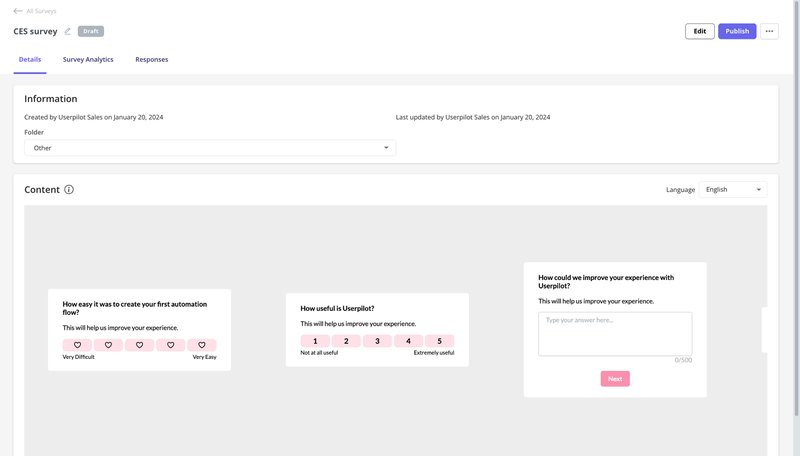
How do you calculate the adoption rate?
Calculating the adoption rate of your product gives you a clear picture of how many users are actively engaging with what you offer. The formula to calculate the product adoption rate is quite straightforward:
Product Adoption Rate = (New Active Users / Total Signups)×100
But what counts as “active” use? Well, that depends on how users adopt your product. For some, it’s daily; for others, it might be used to log in a few times a month or complete a set of key actions. Metrics you should consider include:
- DAU/MAU: The ratio of daily active users to monthly active users.
- Conversion rate: The percentage of users who take a desired action.
- Churn rate: The rate at which customers stop using your product.
- Usage frequency: How often users engage with your product.
- Time spent: The average time a user spends with your product.
- Customer lifetime value (CLV): The total worth to a business of a customer over the whole period of their relationship.
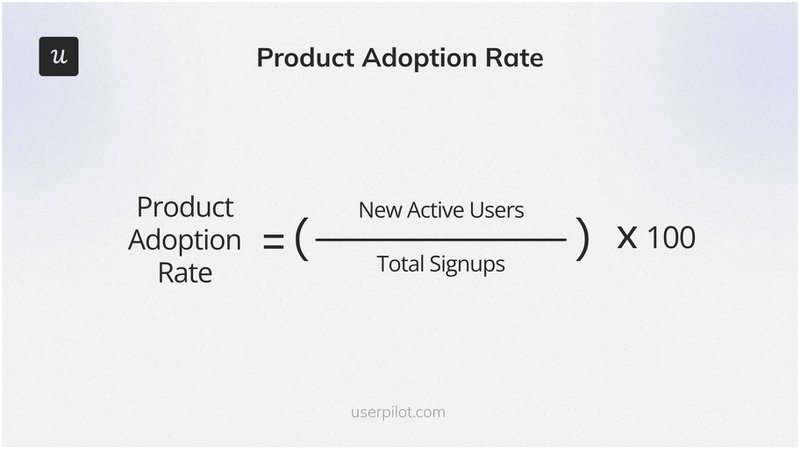
Improving your adoption rate with Userpilot
Enhancing your product’s adoption rate can be a multifaceted challenge, but with Userpilot, it becomes a data-driven and user-focused endeavor. Userpilot’s suite of tools and features is designed to help you track and improve your adoption rate.
- Onboarding: Userpilot offers customizable onboarding flows that guide your users from the moment they sign up, highlighting key features and benefits to set the stage for increased adoption.
- In-app experiences & guidance: You can create tailored in-app experiences that provide contextual guidance, ensuring users find value in your product quickly and efficiently.
- Tracking product/feature usage and engagement: Userpilot’s product adoption dashboard gives detailed insights into user behavior, feature usage frequency, and engagement levels.
- A/B testing: You can test different versions of your onboarding flows, feature announcements, and in-app messages to see what resonates best with your audience and drives the highest adoption rate.
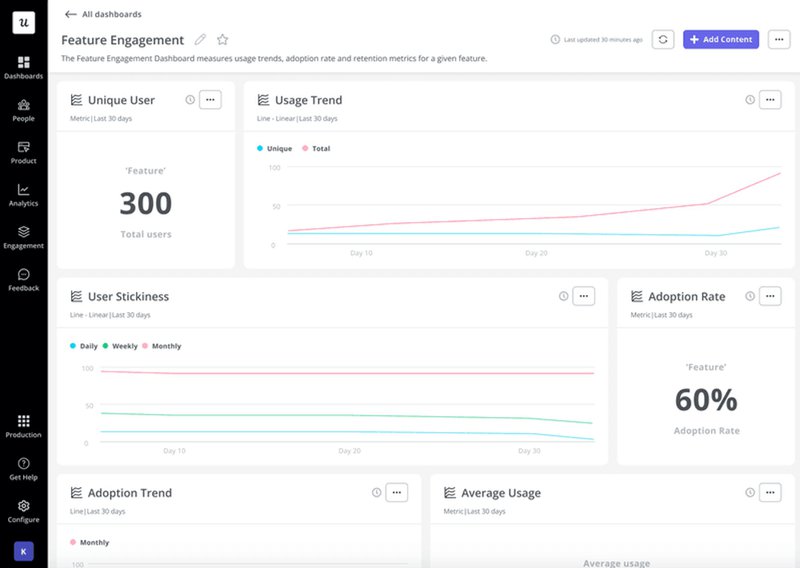
Conclusion
Increasing your feature adoption rate is a metric you should continue improving in your product. The more you can get customers to adopt new features, the more likely they will remain customers, helping you retain them for longer.
If you want help with strategies to increase your adoption rate, like user onboarding, A/B tests, and product analysis, find out how Userpilot can help by booking a demo now.








